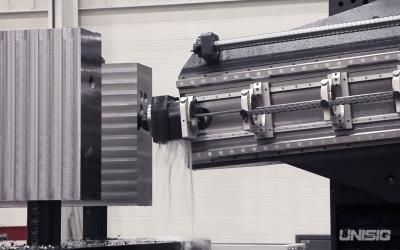
To help mold makers achieve the highest levels of milling and deep hole drilling productivity, UNISIG introduces two new models to its successful USC-M series – the USC-2M and USC-3M. The new 2M/3M machines handle the rigors of both milling and gundrilling metals of all types, but do so with a single, powerful universal spindle. Both models feature rigid, robust frames along with their universal spindles for the toughest applications, all of which helps mold makers minimize machining time and maximize throughput.
Mold makers require world-class milling capabilities and accuracy, which is why the new USC designs emphasize rigidity and stability. With CAT 50 spindles up to 40 horsepower, these machines deliver high-torque milling capabilities for aggressive metal removal and shorter cycle times.
“We believe mold makers will truly benefit from the machining capabilities of these two new models,” said Anthony Fettig, CEO of UNISIG. “By introducing a pair of universal spindle options, we now offer manufacturers of all sizes a complete line of mold making solutions. The new machines exemplify a continuation of our commitment to meeting customer needs without compromising on quality or accuracy”.
Thanks to the single, universal spindle designs of the USC-2M and 3M, mold makers will significantly reduce changeover times when switching between gundrilling and milling operations. Additionally, a 60-position automatic tool changer helps further minimize nonproductive time. Both models have the capability to run oil and water- soluble coolant as well. For further time and cost savings, the USC-2M and 3M feature fully enclosed machining envelopes that are installed above the shop floor, allowing customers to avoid time-consuming, costly below-ground installations.
Contact Details
Related Glossary Terms
- coolant
coolant
Fluid that reduces temperature buildup at the tool/workpiece interface during machining. Normally takes the form of a liquid such as soluble or chemical mixtures (semisynthetic, synthetic) but can be pressurized air or other gas. Because of water’s ability to absorb great quantities of heat, it is widely used as a coolant and vehicle for various cutting compounds, with the water-to-compound ratio varying with the machining task. See cutting fluid; semisynthetic cutting fluid; soluble-oil cutting fluid; synthetic cutting fluid.
- gang cutting ( milling)
gang cutting ( milling)
Machining with several cutters mounted on a single arbor, generally for simultaneous cutting.
- gundrilling
gundrilling
Drilling process using a self-guiding tool to produce deep, precise holes. High-pressure coolant is fed to the cutting area, usually through the gundrill’s shank.
- milling
milling
Machining operation in which metal or other material is removed by applying power to a rotating cutter. In vertical milling, the cutting tool is mounted vertically on the spindle. In horizontal milling, the cutting tool is mounted horizontally, either directly on the spindle or on an arbor. Horizontal milling is further broken down into conventional milling, where the cutter rotates opposite the direction of feed, or “up” into the workpiece; and climb milling, where the cutter rotates in the direction of feed, or “down” into the workpiece. Milling operations include plane or surface milling, endmilling, facemilling, angle milling, form milling and profiling.

